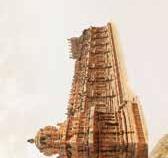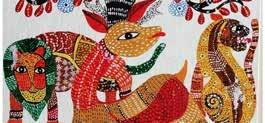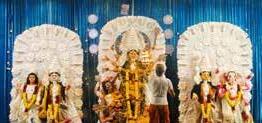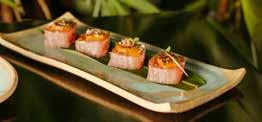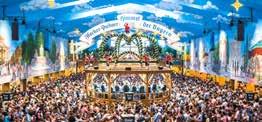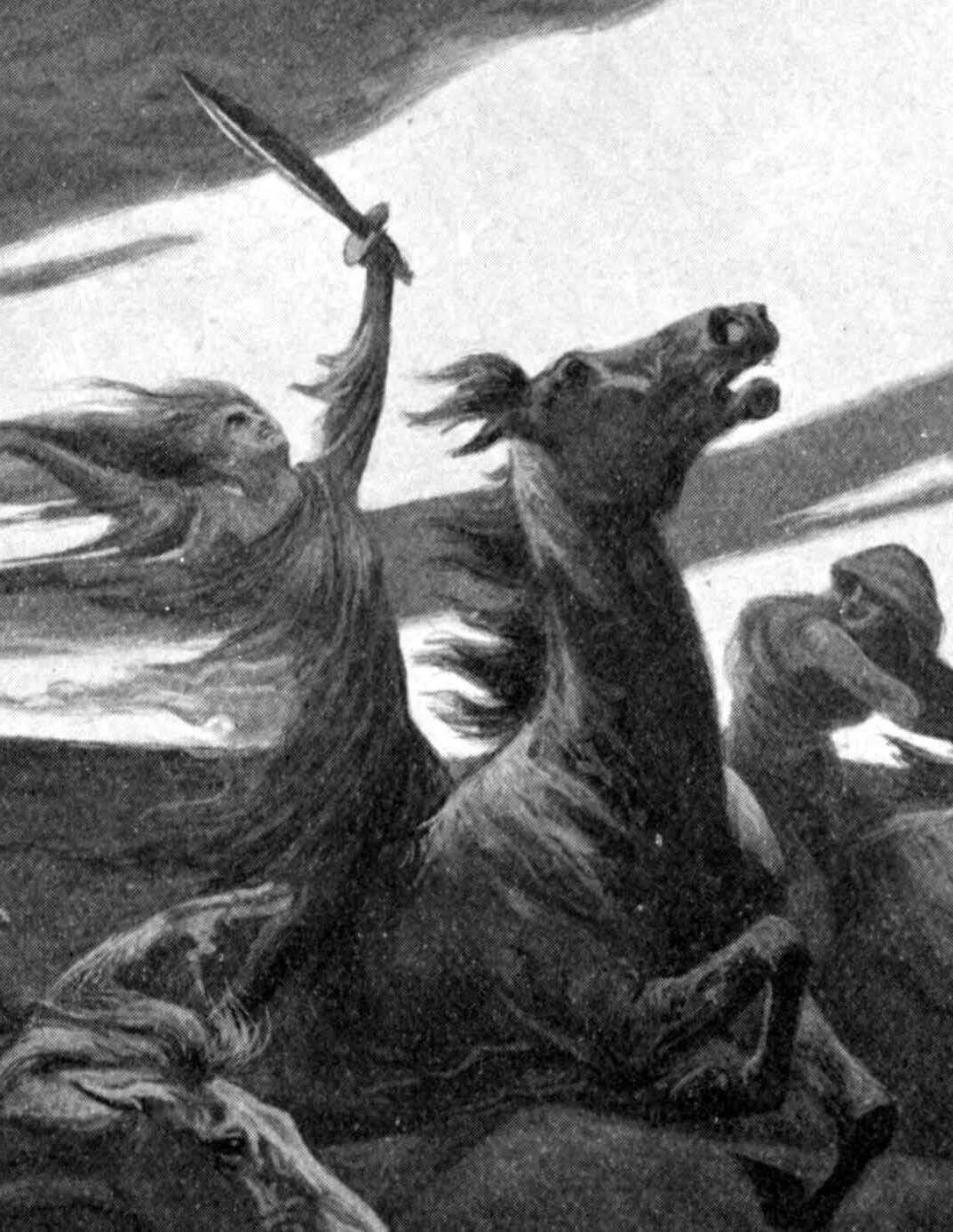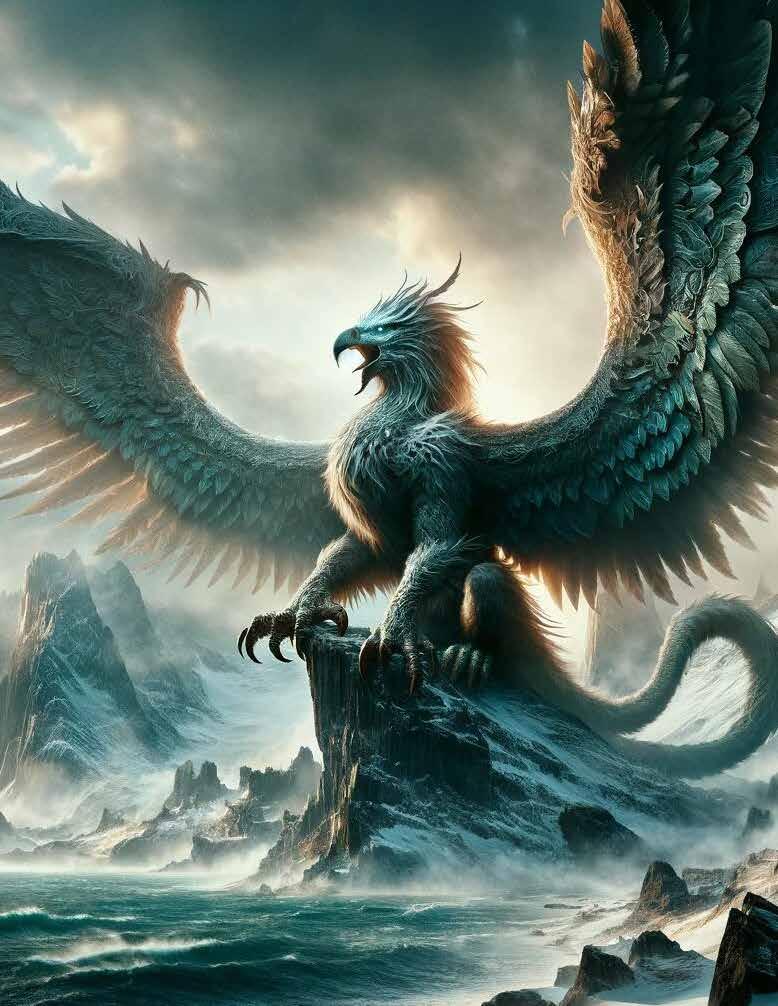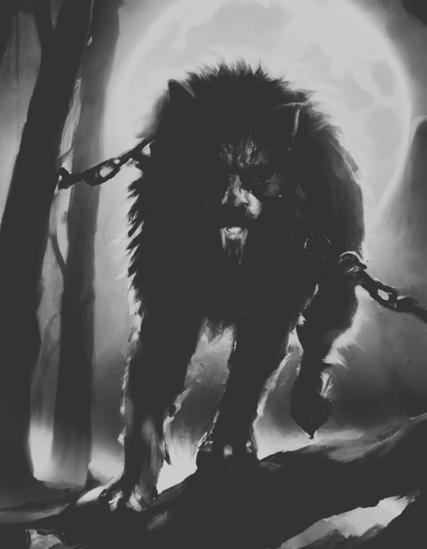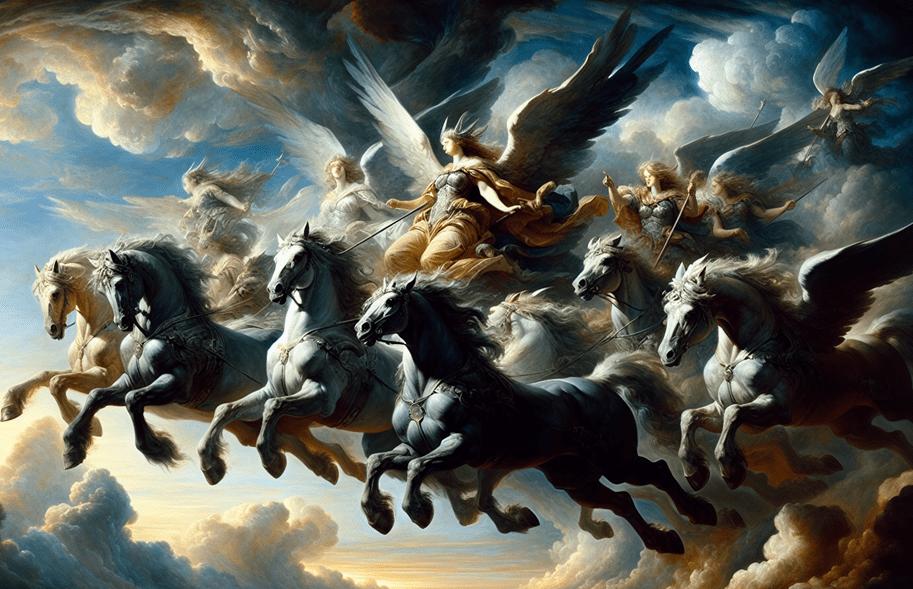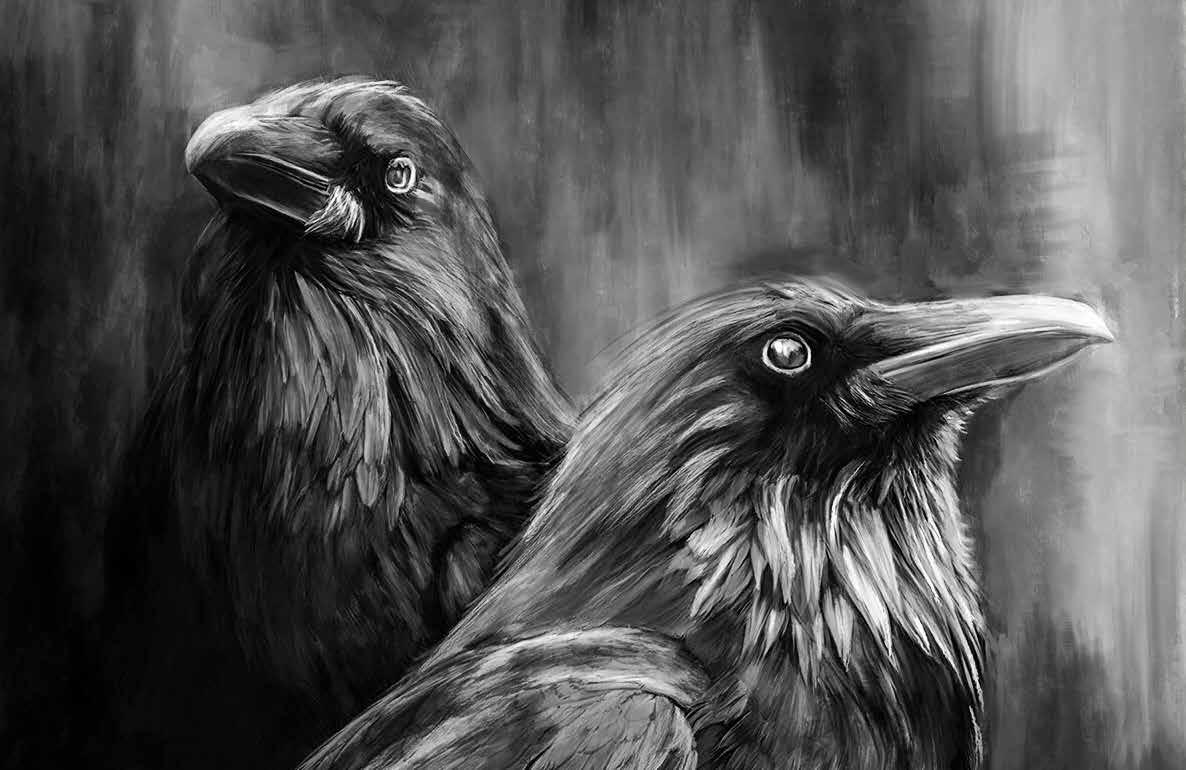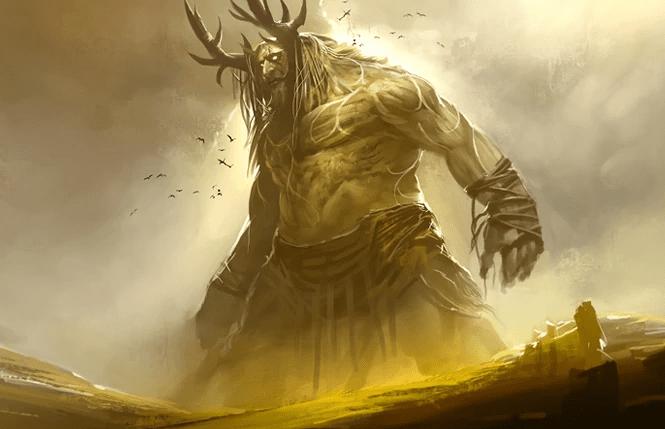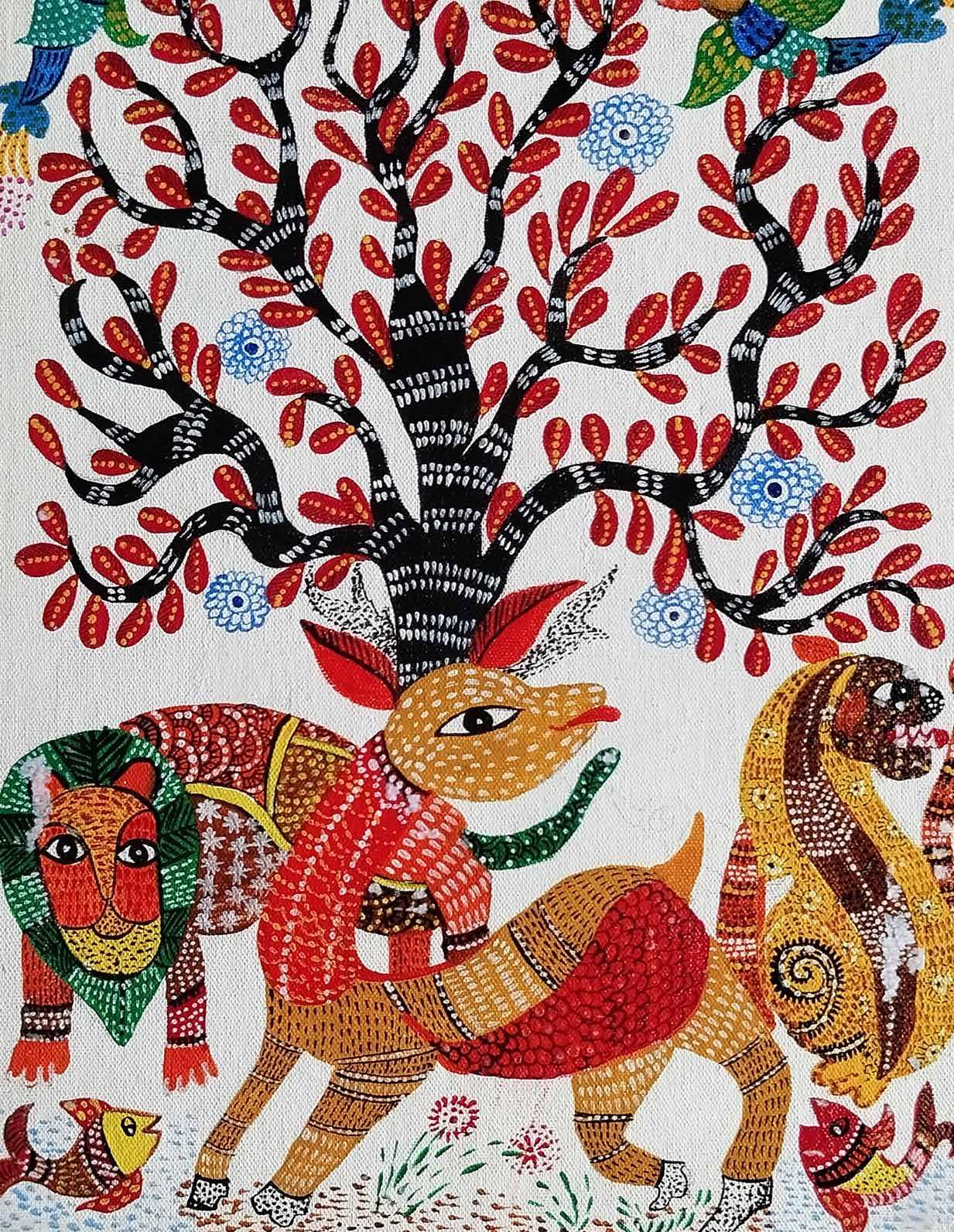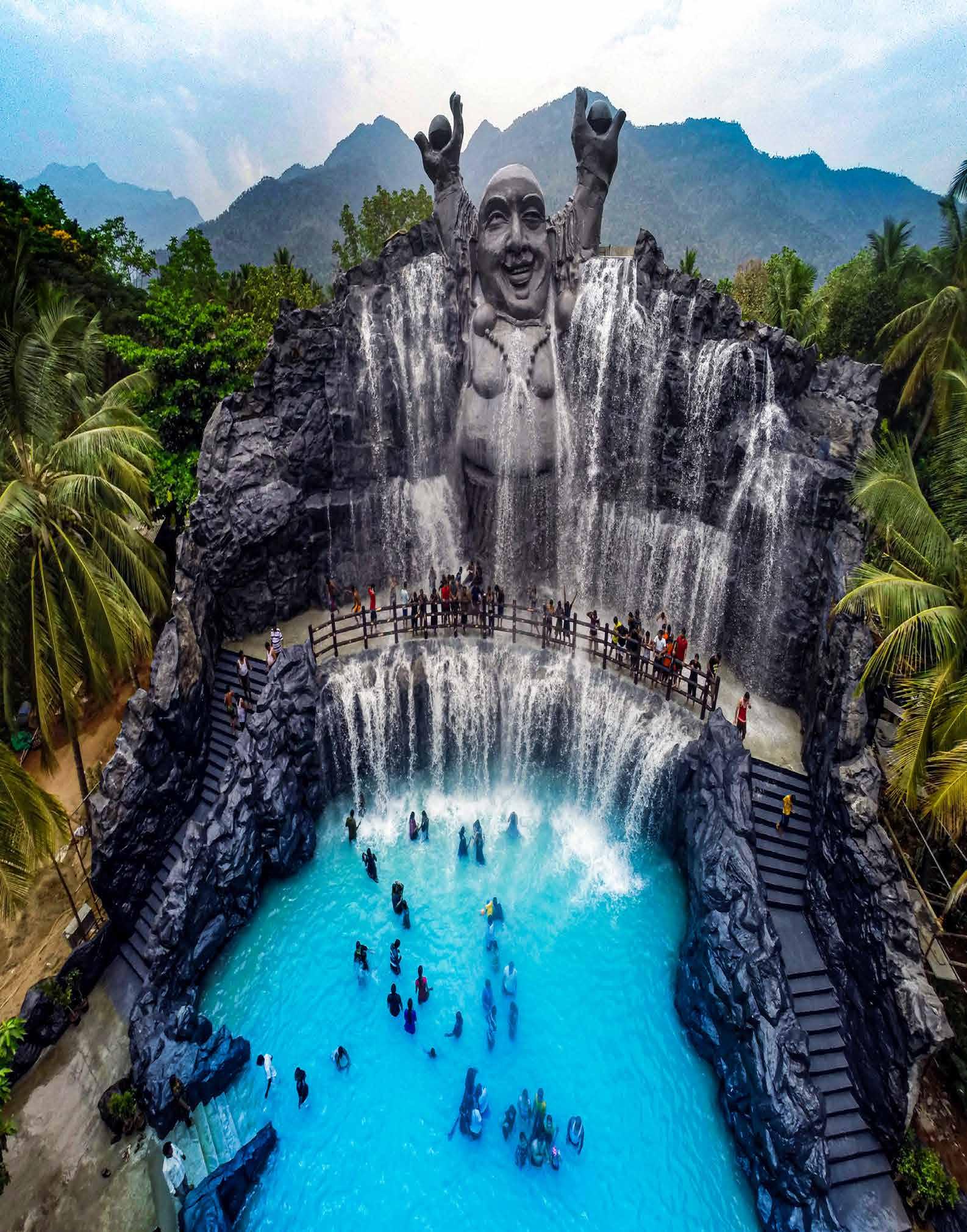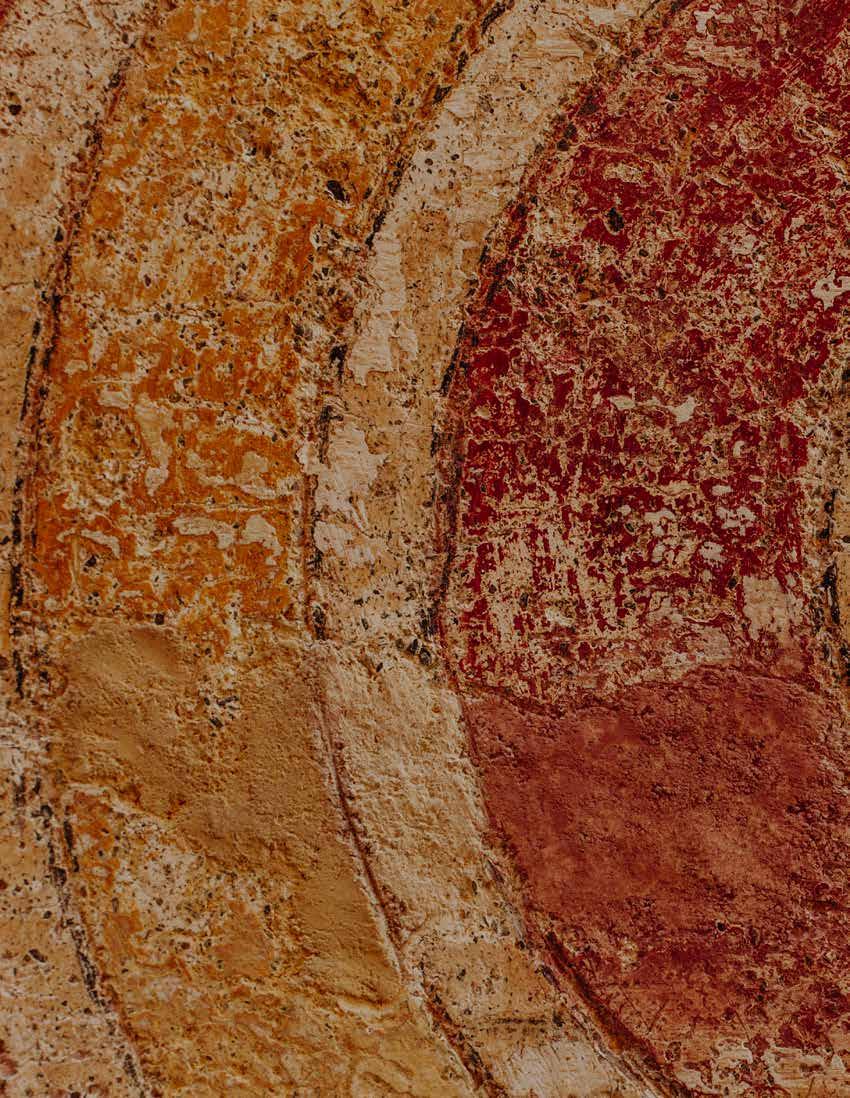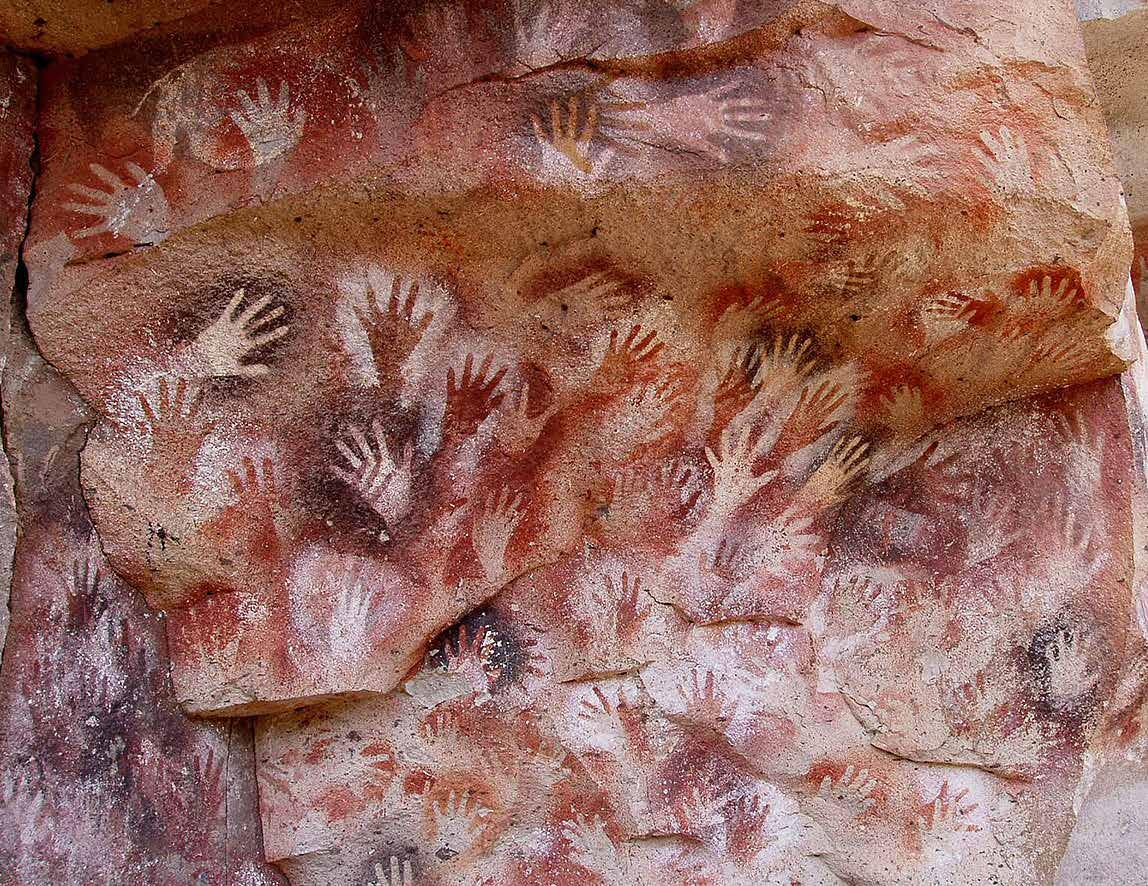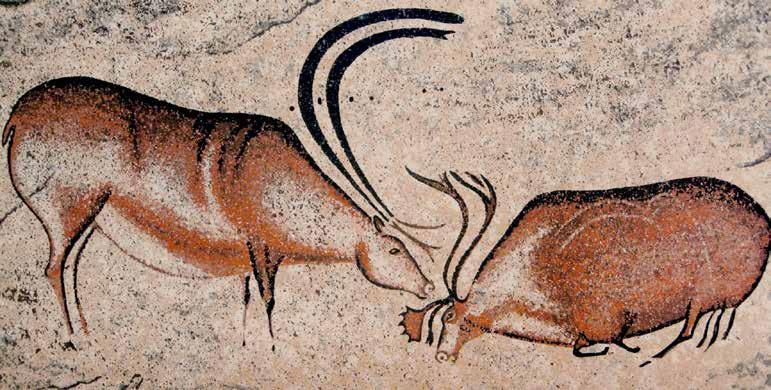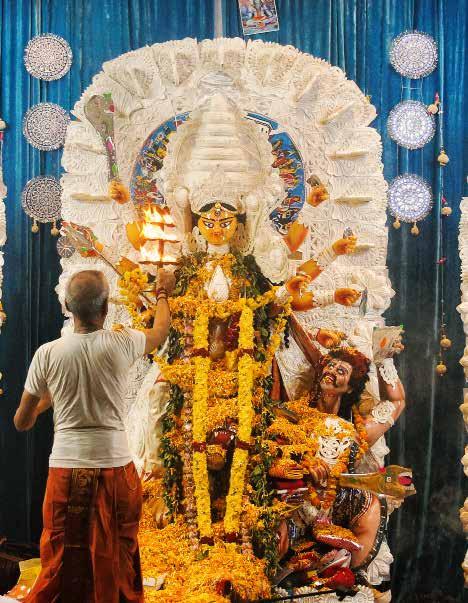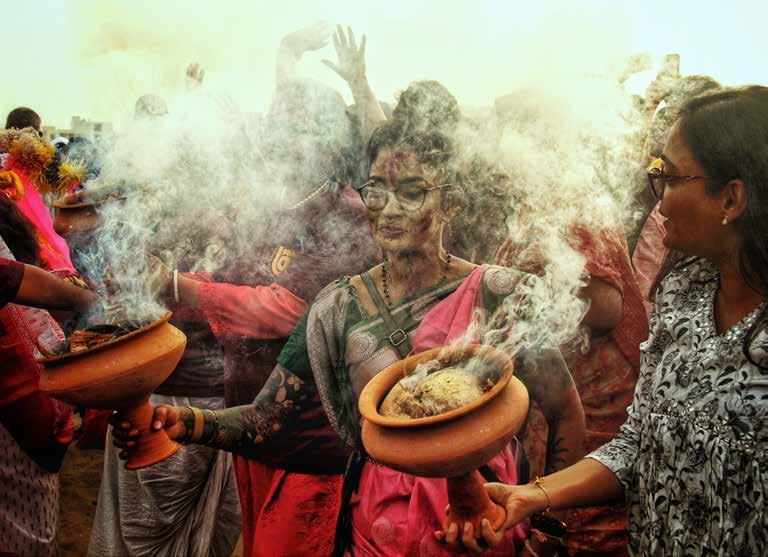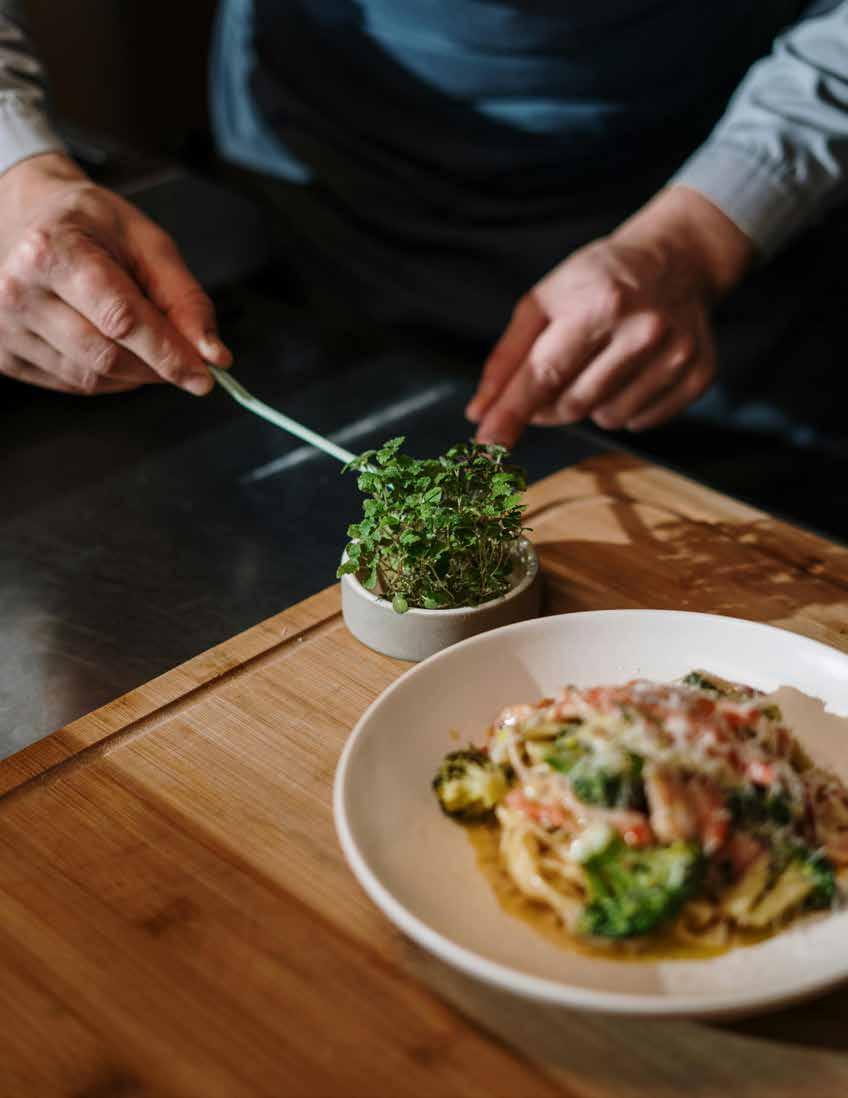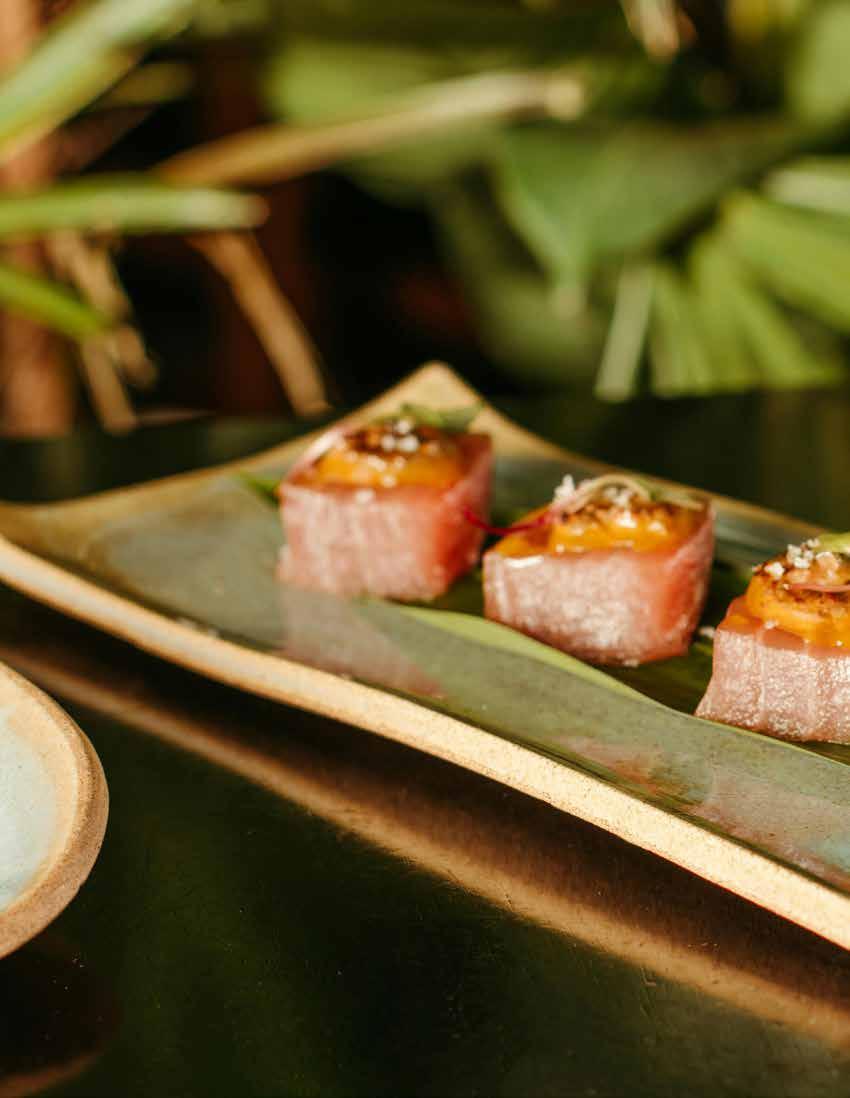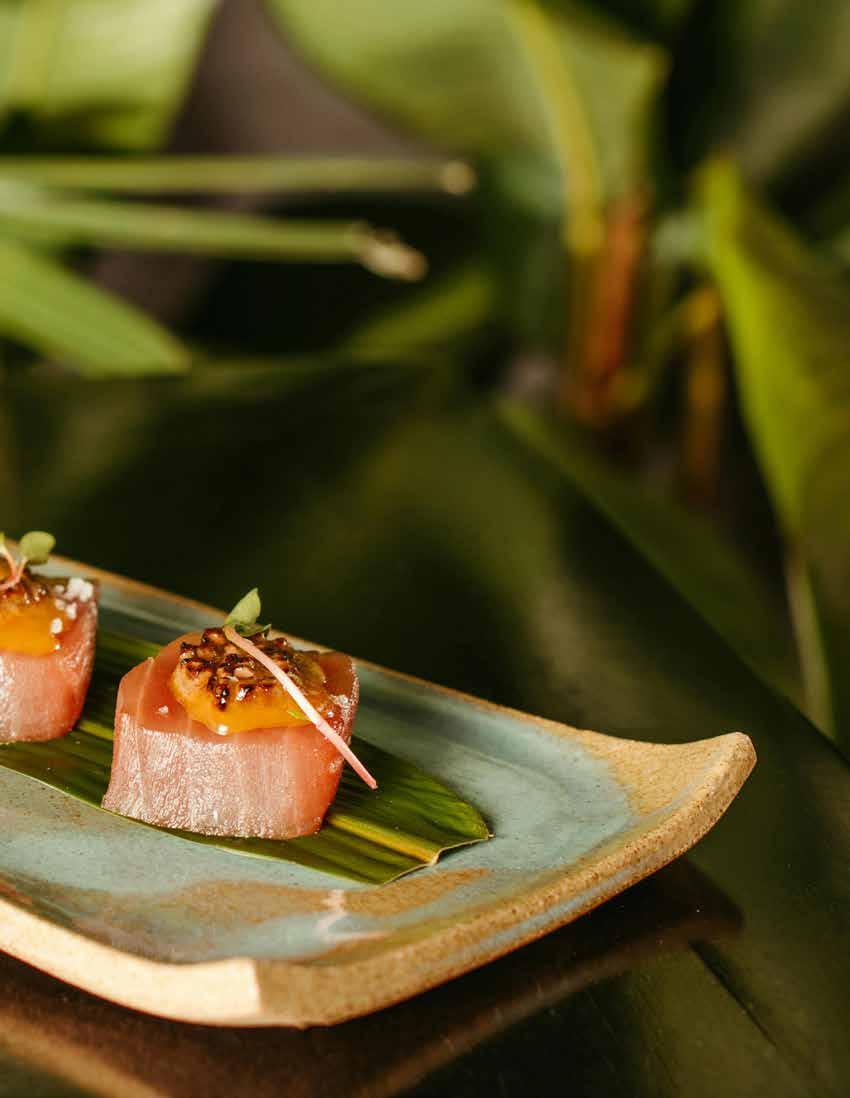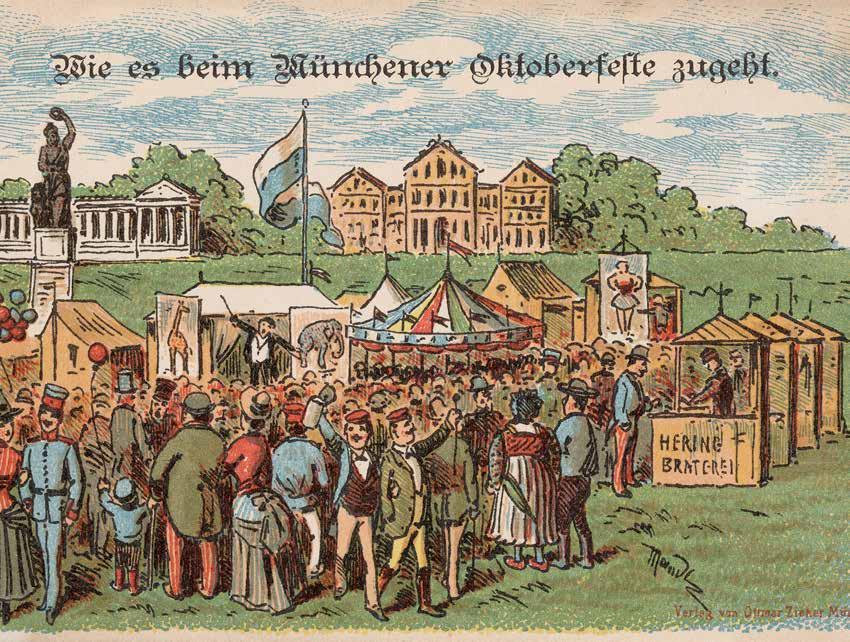Dear Brew Readers,
As the sun settles down, for its yearly leisure, we are here to give you something to be relaxed about. Stories of art, travel and food. A perfect medley of Brew's very own cocktail. In this pleasing weather, sit back and enjoy a cup of hot chai and your favorite fritters, with a twist of our irresistible reads. To many more fascinating stories, history and present events. Turn the pages or swipe right for a captivating time. Catch you next month!
Happy reading and happy brewing!
Love, Brew
Denver Fernandez
In a world where reality and myth intertwine. Where the branches of a cosmic ash tree cradle the nine realms of existence, and where gods and monsters wage an eternal struggle for supremacy; Where wolves can swallow the sun and a simple squirrel whose gossip-mongering antics span the heights and depths of Yggdrasil itself.
We delve into these legends and discover how each being embodies fundamental forces of nature, concepts of order and chaos, and the eternal cycle of creation and destruction that defines the Norse worldview.
1. Jörmungandr (The Midgard Serpent)
The enormous sea serpent offspring of Loki and the giantess Angrboða, Jörmungandr is so large it encircles the entire world and grasps its tail. In Norse mythology, it represents the outermost boundaries of the mortal realm, Midgard. Jörmungandr is destined to fight Thor during Ragnarök, the final battle. Their confrontation is prophesied to end with Thor slaying the serpent but succumbing to its venom nine steps later, symbolising the cosmic balance of victory and defeat.
2. Fenrir
A monstrous wolf, also Loki’s offspring with Angrboða, Fenrir plays a crucial role in Norse tales. Prophesied to kill Odin during Ragnarök, Fenrir represents the forces of chaos that threaten cosmic order. The Æsir gods, fearing his growing strength, tricked and bound him
using a magical rope called Gleipnir, crafted by dwarves from impossible things like the sound of a cat’s footfall and the roots of a mountain. This binding cost the god Tyr his hand, showcasing the price of maintaining order. Fenrir’s breaking free at Ragnarök signifies the unleashing of primordial chaos.
3. Sleipnir
Odin’s eight-legged horse, considered the fastest of all creatures, Sleipnir symbolises Odin’s role as a psychopomp, guiding souls between worlds. Born to Loki while in the form of a mare, Sleipnir’s unusual parentage reflects the fluid nature of boundaries in Norse mythology. His eight legs are thought to represent the eight directions of the compass, emphasising his ability to traverse all realms. Sleipnir is also associated with shamanic practices, serving as a mount for spiritual journeys between worlds.
4. Ratatoskr
A squirrel that runs up and down Yggdrasil, the world tree, Ratatoskr carries messages between the eagle at the top and the dragon Níðhöggr at the roots. More than just a messenger, Ratatoskr is known for spreading gossip and sowing discord, embodying the concept of miscommunication and conflict between different realms of existence. Its constant movement up and down Yggdrasil represents the flow of information and energy through the cosmos.
5. Níðhöggr
A dragon that gnaws at the roots of Yggdrasil, Níðhöggr symbolises decay, destruction, and the forces of entropy that constantly threaten the world’s stability. In some interpretations, Níðhöggr represents death and the underworld, feeding on the corpses of the guilty. Its eternal conflict with the world tree reflects the cyclical nature of creation and destruction in Norse cosmology.
6. Hræsvelgr
A giant who takes the form of an eagle, Hræsvelgr sits at the edge of the world. His name means “corpse swallower,” connecting him to death and the passage of souls. By beating his wings, Hræsvelgr creates the winds that blow across the world, influencing both weather and fate. This demonstrates the Norse belief in the interconnectedness of natural phenomena and mythological beings.
Female warrior spirits who serve Odin, the Valkyries choose who lives and dies in battle. Their role connects warfare, fate, and the afterlife in Norse belief. By bringing chosen warriors to Valhalla, Odin’s hall, they prepare an army for the final battle of Ragnarök. Valkyries also serve mead to the einherjar (chosen warriors) in Valhalla, embodying both martial prowess and hospitality.
Odin’s ravens, whose names mean “thought” and “memory” respectively, represent Odin’s far-reaching wisdom and knowledge. They fly around the world each day, bringing information back to Odin, symbolizing his omniscience and connection to all realms. Their daily flight mirrors Odin’s constant quest for knowledge, even at great personal cost, as reflected in myths where he sacrifices an eye or hangs himself to gain wisdom.
8. Huginn and Muninn
7. Valkyries
9. Jötnar (Giants)
A race of beings often at odds with the gods, the Jötnar are more complex than simple adversaries. They come in many forms, including frost giants and fire giants, representing primal forces of nature. Some Jötnar, like Skadi or Gerdr, become integrated into the pantheon through marriage, highlighting the fluid boundaries between different categories of beings in Norse mythology. The ongoing conflict and occasional cooperation between Æsir and Jötnar represent the dynamic balance of cosmic forces.
10. Skoll and Hati
The cosmic wolves of Norse mythology, embody the eternal chase across the heavens. Sons of Fenrir, they pursue the sun and moon, threatening to devour these celestial bodies and plunge the world into darkness. Skoll hunts Sol, the sun, while Hati pursues Mani, the moon. Their relentless pursuit symbolizes the constant cycle of day and night, light and darkness. At Ragnarök, it’s prophesied they will finally catch their prey, heralding the end of the world. This menagerie
of beings in Norse mythology offers us a window into the soul of an ancient culture, one that grapples with the same fundamental questions we face today. They remind us that mythology is not merely a collection of fantastic stories, but a profound exploration of the human condition. As we stand at the foot of our own metaphorical Yggdrasil, we might find that the wisdom of the Norse – their respect for nature’s power, their acknowledgement of life’s dualities, and their courage in the face of fate – still resonates, offering guidance as we navigate our cosmic journey.
Ancient Chronicles of the Gond:
These aboriginal tribes led a simple, nomadic lifestyle with temporary seasonal settlements. They used tools such as bows and arrows for hunting, and grinders and hammers to process plant food like roots and tubers.
In the 14th century, this large tribal group was split by the Mughal invasion, leading them to relocate to the Vindhya and Satpura regions, known today as Chhattisgarh, Maharashtra, Andhra Pradesh, and Orissa. Despite this, they remain one of the largest tribes in Central India, numbering about 13 million people at present according to recent studies.
Traditional Gond art comprised dance, songs, and wall paintings. The term ‘Gond’ originated from the word ‘Kond’ which translated into ‘Green Mountain’. Their style of art is inspired by natural elements, like forests, rivers, mountains, skies, and animals, and cultural depictions like mythological stories and characters, mainly of Goddess Shakthi and Lord Ganesha. During their brief stays in places like caves and rock formations, tribe members passed on cultural knowledge through song and dance in the form of stories and also documented their surroundings and lifestyle.
This was done through etchings in the form of engravings, carvings, and paintings on
boulders, caves, and rock shelters. Whether for communication, record-keeping, or pastime, it was from these practices that the unique Gond art form of the Gond tribes was born. The tribe celebrated festivals such as Diwali or Nag Panchami and many other significant occasions, the members of the tribe celebrated with great pomp and created an ambient atmosphere by getting together, decorating their homes, streets, and pathways with colorful paintings comprising varied patterns exclusive to the Gond style.
The patterns and strokes used are exclusive to their tribe, however, little is known about the significance of each pattern. Some patterns used
are dots, lines, fish scales, curved lines, water droplets, seeds, and geometric shapes. There is enough evidence about how the tribe revered the cosmic entities, nature, and wildlife and most importantly, their immense belief system in the religious aspects. What’s interesting is the Gond people’s choice of materials for painting. Every ingredient sourced to prepare the paints and brushes is natural.
They show utmost care to select and work mainly with vibrant colors such as crimson red, navy blue, forest green, turmeric yellow, magenta, rosy pink, and bright orange are some of the commonly used colors, ultimately bringing the elements of
the paintings to life! Even more fascinating is their unmatched quality and precision maintaining the painting’s luster over time. Let’s now look into what are the various natural products used to derive these colors. The crimson red is extracted from the local clay soil which is heated to a certain temperature, resulting in desired red.
It is then ground into a fine powder For turmeric yellow, yes, you guessed it right, turmeric is dried completely, and ground into fine powder. For pink, it is dried bougainvillea flowers; for magenta, it is beetroot powder; for green, the leaves of different plants based on the shades are used, and for black, it is charcoal. The characters in the painting mainly consist of animals and birds such as Deer, Fish, Peacock, Lion, Tiger, Bison, Cows (considered sacred according to their Hindu culture), Porcupine, Snakes, Tortoise, etc. The inclusion of trees with spiritual importance amongst the tribe.
The stories attached to these trees are depicted in many paintings by famous artists. They believe that the lives of humans and trees are interconnected and that one cannot exist without the other. One such painting is of the Mahua tree titled “Tree of Life”. Famous artists have depicted this concept as it is a well-known fact that the Mahua Tree plays a very significant role in every Gondi. The Mahua fruits and flowers are a great source of vital nutrients. The fruits can be eaten raw or cooked. The pulp from the fruits and flowers is also a source of sugar used in various dishes. The flowers are used to produce an alcoholic drink which is usually consumed on festive occasions. The seeds are used as biofuel.
As mentioned earlier, storytelling was an integral part of the entertainment aspect among the tribes. Storytelling through the form of paintings sounds challenging, however, it came naturally for them to depict them on a single image or through a series of scenes. Below are a few short stories narrated as paintings that have gained popularity over time.
Story depiction of the Mahua Tree:
Here is another interesting story of a Brahman girl (Upper caste in those days) and a Chamar boy (lower caste in those days) who fell in love with each other. However, this relationship was not entertained by their community. As any love-smitten couple would do in Bollywood movies, they eloped into a forest and lived there forever. As legend says, the boy was reborn as Ganja and the girl as the Mahua tree. Hence, it is said that Ganja and Mahua are forbidden to be consumed together, as they can never be together according to that community of Aboriginals.
Story depiction of Deity Pashupati:
The Aboriginals of the Gond tribe worshiped Lord Shiva as their deity, in this famous story, Pashupati once drank Somras made out of Mahua flower. With the first few sips, he was intoxicated and started babbling like a Parakeet, he furthermore downed a few sips and roared like a tiger. Again, he gulps a few more sips of the fermented drink, his feet aren’t standing on the ground and starts rolling on the ground like a boar. This has been beautifully depicted below, a painting made by renowned Gond artist Sri. Rajendra Raju Shyam.
Sri Bhajju Shyam:
Nephew to the renowned Sri Jangarh Singh Shyam, Sri Bajju Shyam took inspiration from his mother and uncle and pursued a career in Gond art. He has received global recognition, a few among which are, the famous award winning book called The Night Life of Trees and London Jungle Book.
A few noted Gond artists:
Sri Jangarh Singh Shyam:
He was one of the first in the community to become a pioneer in Gond art and the reason for the worldwide recognition of Gond art form. Originally hailing from the Pardhan Gond community of Madhya Pradesh, the artist was considered a cultural ambassador not only in tribal art but also was an excellent flutist. From stepping into the national forum by getting a chance to work at Bharat Bhavan, Bhopal, a prestigious museum for Indian tribal, traditional, and contemporary art, in 1988, to receiving a global platform at two of the most reputed exhibitions, where he participated in the Jyotindra Jain’s Other Masters exhibition at the Crafts Museum, New Delhi in 1998, and Magiciens de la terre exhibition, conducted at Paris in 1989. Through these laurels, out of his humbleness, his dream was fulfilled when he started the Jangarh Kalam or Jangarh Singh Shyam presenting the Pardhan Gond art which instilled a creative energy that was harnessed by individual power and talent for the art.


Smt. Durgabai Vyam:
Smt. Durgabai Vyam is the sister-in-law of Jangarh Singh Shyam and also a very renowned Gond Artist. Currently living in Bhopal, she started painting at six years of age and apprenticed under Jangarh Singh Shyam. The main pattern used in her style of painting is paddy seed. She also co-authored the children’s book, The Nightlife of Trees alongside Sri Bhajju Shyam, which won the Bologna Ragazzi Award in 2008.
A Correlation between the Gond Aboriginals and the British:
Many have wondered about the fact that the British have nothing to do with the Gond tribe. However, let me introduce you to Mr. Verrier Elwin, a British anthropologist, sent to India as a Christian Missionary in 1927. He was dumbstruck by the superior thinking of the yet so simple community of our tribal folks in India and decided to work in favor of them under the guidance of the then Prime Minister, Mr. Jawaharlal Nehru.
After a few years of service, he went on to marry a woman from the Gond community, going against their family’s efforts to talk him out of it. Later, he went on to bear a son and also married another tribal woman. Throughout his stay in India, he went on to come up with a book comprising of a varied collection of fables he came across from different communities, from different parts of the Indian tribal region, titled, “When the World Was Young”. Like this gentleman, there are many patrons like Sri Jagdish Swaminathan, who took the greats like Sri Jangarh Singh Shyam and trained them to be skilled artists, because of whom the community has benefited significantly. However, it is not always a rosy picture, as there are many challenges that the art
form faces. Time and modernity have made it difficult for the people of Gond to look for additional sources of income, or rather, a high-yielding income, which is driving them to look for alternatives as laborers or become farmers.
Measures to conserve Gond art:
Environmental factors also play a major role in the dwindling art form, as the natural raw materials are hard to source freely as in the past. The authenticity is lost while implementing the usage of chemical paints as there are a few shades that natural colors produce, which are hard to replicate with chemical ones.
To preserve and document the Gond Tribal art, the Government of India is making tremendous efforts by launching various schemes under numerous cultural institutions to promote and encourage young people of the tribe and others to pursue this form of art as a livelihood, such that the art is preserved and passed on to the generations to come. It is these cultural implications that are the sole eloquences of our tribal voice. At present, Gond art occupies an important place among art lovers. Though there have been many global recognitions, we can hope that there is more such cultural acceptance throughout.
Anmol Mishra
Regions and Their Iconic Ingredients
1.
Truffle Hunting in Piedmont, Italy
In Piedmont, Italy, truffles are not just ingredients; they’re treasures, carefully unearthed from the cool soil beneath oak and beech trees. The white coveted truffle is incredibly rare and aromatic, earning the nickname “white gold.” The truffle hunt itself is an experience. Expert hunters and their trained dogs sniff out these treasures in the early morning hours to maximize the chances of finding truffles. At the Alba White Truffle Festival, travelers can sample truffle-infused dishes and witness live auctions. Here, tasting a dish seasoned with freshly shaved truffle is like tasting Piedmont’s essence.
2. Saffron Harvesting in Khorasan, Iran
In the golden fields of Khorasan, Iran, saffron crocuses bloom in October and November, producing the vivid red threads that make saffron one of the world’s most precious spices. Iran produces over 90% of the global saffron supply, and its high price stems from the laborintensive process. The harvest involves families rising before dawn to pick flowers while they’re still closed, preserving the spice’s delicate flavor. Saffron’s history in Persian culture runs deep; it was traded along the Silk Road and continues to infuse Persian cuisine, from
3. Vanilla Orchids in Madagascar
Madagascar’s warm, humid climate and volcanic soil create ideal conditions for growing vanilla. Each orchid blooms for just 24 hours, requiring hand-pollination, which is a precise task for skilled farmers. After harvest, green vanilla beans undergo a meticulous curing process that takes months to develop their complex flavor. Madagascar’s vanilla plantations welcome travelers to learn about this painstaking process, offering tours where visitors can inhale the exotic, intoxicating aroma of vanilla in its purest form.
4.
In Andalusia, Spain, olive groves stretch for miles, their silver-green leaves shimmering under the Mediterranean sun. The mild winters and warm summers make this region one of the top producers of the world’s finest olive oil, revered for its fruity flavor and golden color. During harvest, both traditional and modern methods are used to press the olives into liquid gold. Andalusian olive oil is often enjoyed raw, with locals saying, 'You can taste the sun in every drop. Travelers can immerse themselves in olive oil festivals that showcase tastings, cooking demonstrations, and cultural performances, immersing visitors in Andalusia’s rich traditions. And just like olive oil, Quebec’s maple syrup harvest brings its own unique flavor to the mix.
Olive Groves in Andalusia, Spain
5. Maple Syrup Harvest in Quebec, Canada
Quebec’s forests come alive each spring with the maple syrup harvest, a tradition where the sap of sugar maple trees is tapped and boiled down into the beloved syrup, also known as 'liquid gold.' Quebec produces over 70% of the world’s maple syrup supply. Visitors to sugar shacks, or cabanes à sucre, can watch syrup being poured over the snow to create 'tire d’érable,' a traditional taffy treat. Travelers can experience the entire process of sugaring
6. Coffee Cultivation in Colombia’s Coffee Triangle
Colombia’s Coffee Triangle, the mountainous region with its volcanic soil and lush climate creates perfect conditions for cultivating Arabica beans, which are known for their balanced flavor and vibrant aroma. Farmers in Caldas, Quindío, and Risaralda handpick only the ripest beans to ensure top quality. In Colombia, coffee isn’t just a drink; it’s a way of life. Known as el oro negro or black gold, it carries the heart and heritage of the country. Every cup fuels conversations and strengthens community bonds. Visiting family-run farms here is like stepping into Colombia’s soul. Travelers can join guided tours to see the care and craft that go into roasting, grinding, and brewing. With each sip, you’re not just tasting coffee—you’re savoring the land and the passion of its people.
7.
Spices of Kerala, India
Kerala, often called the 'Land of Spices,' is where food, culture, and history blend seamlessly. For centuries, its black pepper, cardamom, cinnamon, and cloves have been coveted treasures in the global spice trade. Imagine walking through the lush Western Ghats, where the air hums with the earthy aroma of sun-dried peppercorns and the sharp citrusy tang of freshly crushed cardamom. Here, spice cultivation isn’t just a practice—it’s an art, passed down through generations.
You can watch this magic unfold, try grinding your own spice blends, or even join the vibrant Spice Route Culinary Festival in Kochi. This annual celebration brings to life Kerala’s rich spice heritage and its remarkable influence on global cuisine. From spices to sweet indulgences, we've traveled across continents to uncover these culinary treasures. As we wrap up this journey, it’s clear that each ingredient not only flavors a dish but also tells the story of a region, its people, and its heritage. So, next time you're hungry for an adventure, think about the flavors you could discover. Every ingredient has a story, and each dish can take you to places and cultures that will stay with you long after the last bite.
Sahana Subramanya
The Advent of Cave Painting Progression
Picture what it was like, at the far end of a prehistoric cave, where darkness loomed inside, the flickering torch sticks made out of a piece of wood, tree sap and fire lit by striking stones, illuminating the walls like a gallery. The cave walls adorned with flaming reds, bright yellows, and ebony blacks depict a bygone era – a world consisting of swarming hordes of fearsome animals like the large predators, bison, mammoths, and the artistic hand crayons and natural paint extracts. These cave paintings, however, tarnished by the rigorous course of changing millennia, tell important stories from the beginning of time, offering a wide-angle glimpse into the living conditions and life forms that existed, evolved and went extinct. Their evolution, which took place gradually, passing millennia, showcases art not only as a form of record but also the potential rise of language as a means to communicate.
When Artistic Expression took Command
The primaeval strokes of artistic expression date back far beyond than deciphered. Some current discoveries in Indonesia confirm the dawn of cave paintings at a shocking 45,500 years back, contradicting the laurels the Europeans have claimed since a few tens of thousands of years ago.
The early works ever recorded often contained rough strokes, geometrical shapes and lines and dots. Initially, they drew my hand using pieces of charcoal, or ash. The favourite recurring across most continents was the simple use
of hand stencils, proven to be highly effective in analysing ancient art for details.
Because of this, many theories originated, proving their purpose, ranging from marking to determine the pack size, or population density, to rituals connected to the circle of life, or figuring out the very reason for existence. Perhaps this was how the concept of signature came into existence.
Gradually in time, cave art transformed for the better, transitioning from simpler strokes and patterns to more in-depth forms of art such as drawing humans,
animals and naturally occurring phenomena like trees, mountains, the sun and the moon, of animals, etc. The concept of an object form, perception and running images was discovered in Chauvet and some parts of Lascaux and other regions surrounding them and is estimated to be between 16,000 and 37,000 years old.
The various still paintings found on the walls of these caves had intricate details like different colours used in an image, indicating the depiction of furs being differentiated from other parts of the bodies in old paintings like bison, horses, antelopes and mammoths with a sense of life and dynamic sense.
The Looming Light into Caverns and Crevices: Why Did They Choose Caves?
It is surprising to think why our ancestors chose caves for art and paintings, Despite the darkness looming throughout the caves and the inaccessible caverns. It was because of a combination of multiple factors such as protection from climatic conditions and away from predation. Additionally, another important factor is the setup of the caverns with the acoustics itself. The space inside the cave amplified different kinds of sounds, creating a more wholesome experience while they huddled together to conduct rituals or storytelling for entertainment.
The Neuro Connection in a Twist Towards Civilization
From a more scientific point of view, Neuroscience offers another dimension towards the perspective on cave painting altogether. Studies have shown the act of bringing imagination to life in the form of art, activates reward centres in the brain, leading to feelings of achievement leading to pleasure and satisfaction. Even if the theories of why it came into existence is not clear, the Neuro connection theory heavily supports it. Furthermore, research on mirror neurons suggests that observing and creating art can activate the brain regions that are involved in bringing it from the imagination to the walls of the caves.
Earthy Materials from Nature - The Ancestors’ Palette to Choose from
Our ancestors’ whole life was so rudimentary that hunting, gathering and food and protection were the only main aspects of survival, art was more of a luxury to them. The materials that were gathered were sophisticated beyond comprehension. The colours painted on walls and murals were made of pigments naturally derived from earthy minerals like iron compounds such as ochre (yellow and red), hematite (red), and manganese dioxide (black).
These compounds were primarily ground into powder and then mixed with animal fat or plant binders such as vegetable extracts or plant saps to create a durable paint mixture that could last long enough for them to pass their knowledge and experience to future generations. Since the advent of using tools for fire, slowly it was easy for them to modify tools according to their necessity. And tools used for application were likely plain and simple, as the paint brushes were made from animal fur or bird feathers, or even crushed twigs and sticks to bring out the concept of bristles and then dipped in pigment to paint.
The thought of the sole intent behind these artworks is still subject to questionable debate. One compelling theory is that by depicting scenarios such as the hunting of animals on cave walls, hunters may have a strong belief system of their superiority over the animals and that they have the upper hand of being the predator rather than being prey.
Such a notion may have arrived when they had exclusive access to some of the deepest caves, often difficult to access by other creatures, lending credence to this theory. Here we see it as a deliberate act, a magical, ritualistic practice of performance separating this sacred activity from their mundane lifestyle of hunting and gathering alone. Other theories suggest another possibility which lies in the area of the origin of storytelling and the passing of knowledge from one generation to the other. The cave paintings may have served as a way for early human settlements to document their current state of the world, concerning the weather conditions, environmental changes such as floods or famines, and natural aspects such as figures of trees, rivers and rock formations in general.
Scenarios from their everyday lives also included sharing experiences in the form of stories on successful hunts, encounters with fearsome beasts, and the fascination towards any changes in the celestial phenomena. The addition of capturing human figures to an extent, albeit rare, may further support this notion.
The Incipient Minds: A Bridge to Modernity
The evolution of cave art resonates with a period of significant sensory development in early humans. The progression from simple to complex imagery suggests the newly acquired capability for abstract thought, reasoning on the surrounding factors, and longterm planning and taking simple decisions– all becoming milestones eof modern human complexity of the mind. These artworks may bridge the gap between the sole concerns of survival and the emergence of thought processes.
The Origin of the Concept of Language
The link between cave paintings and the emergence of language is rather an intriguing concept. While there is less proof of the exact relationship,
some learned men and researchers comprehended that cave art could have been a precursor to initial forms such as symbolic communication. The concept of depicting humans, animals and other objects might have paved the way to develop a set of symbols that combined to form scenarios, eventually leading to the origin of spoken language.
The progressive placement of paintings within caves, from drawing figures to connecting them to create scenarios, for the symbols later, suggest an early form of storytelling, a forerunner towards existing modern-day languages.
Facts and Evidence to Comprehend:
The International Style Theory
The widespread similarity in the patterns used in motifs and various techniques used in cave paintings
across vast geographical distributions have resulted in the contemplation of the “International Style” theory. This theory suggests that early humans, from various geographical separations, may have shared similar, if not the exact cultural practices and beliefs which were reflected in their art forms across the globe.
This theory paves the way for the possibilities of diverse interactions between populations of different groups or through the journey of migration, where these art forms and their artistic traditions were shared. This may have been the origin of socialising skills with different communities.
The Chauvet Cave and the “Dawn of Cinema” Theory
Chauvet Cave located in France, was discovered in 1994 and holds a special
spot in the realm of cave art. The paintings in there, which are estimated to date back to about 38,000 years old, are remarkably well-preserved and display a complex use of new perspectives with the use of light. Some of the paintings are positioned to solely exploit natural light glistening through cracks and onto the cave walls, notably creating a dynamic interaction between light and shadow.
This tempted researchers to propose the “Dawn of Cinema” theory, suggesting that Homo sapiens may have discovered the potential for creating illusions of moving images in their sequential paintings.
Hallucinogens and the Altered States of Consciousness
The use of hallucinogenic plants, mainly fungi in some prehistoric and ancient
cultures are well documented to this day. Here, the question arises whether these substances were factors influencing the creation of cave paintings. Some research scholars believe that some inscriptions of unusual animals or celestial geometric patterns could be the experiences of ancestors painting under the influence of hallucinogens. However, factually there is negligible concrete evidence to support this theory, and hence has remained a bleak theory till now.
Advanced Technology Unveiling the Advent of Modernization
Modern technology and new tools are a blessing in disguise for understanding cave art. One such method is the Carbon dating technique widely used, which allows a precise age determination. 3D scanning is another set of techniques to create detailed virtual replicas of
these ancient artworks so that they can be analysed by art stalwarts in understanding cave paintings, enabling them to analyse details invisible to the naked eye and gain a deeper perspective for the artistic skill and mindset of our ancestors.
A Perspective Window into the Stone Age Cave Paintings
Cave paintings are not just ancient and prehistoric doodle creations. They are a testimony to the origin of time, ingenuity, raw imagination, and a shift from the prototype cognitive skills to the complex thinking abilities of our early ancestors. Also offers a glimpse into a world where art, cultural practices and rituals, and survival are intricately intertwined. These interlay of various art forms and stories have laid the foundation for the rich tapestry of human culture and its continual evolution.
Purushoth Appu
There is more to Durga Puja than a religious celebration; in Bengal, it is frequently referred to as the "festival of festivals". It is an exquisite combination of religious beliefs, artistic expression, social cohesion, and cultural expression.
Artistic pavilions, percussion instruments, and the scent of incense are some of the elements that bring Kolkata to life during the Durga Puja festival, which is celebrated with an unprecedented grandeur. Durga Puja is not merely a ceremony for Bengalis all over the world; rather, it is a fervent way of life and a profound connection to their origins.
It's a competition between every neighbourhood to see which one can develop the most stunning and themed structures. The addition of these pavilions, which are frequently influenced by contemporary social issues, historical events, and well-known
monuments, offers the festival several additional dimensions. In addition, the pavilions of Durga incorporate themes that bring attention to social issues like the empowerment of women, climate change, and education-related topics.
In the same vein, the level of craftsmanship that goes into the creation of Durga statues is truly remarkable. Over several months, artisans craft intricate and lifelike depictions of the goddess. Local artists faithfully imitate Bengali culture, although there are Bengalis living in our metropolitan area.
Pavilions for the Durga Puja festival are set up in more than fifteen different locales. The festival of Durga Puja is a celebration of the victory of the goddess Durga over the buffalo monster Mahishasura. Bengalis have a strong belief that it represents the triumph of justice and the eradication of ignorance.
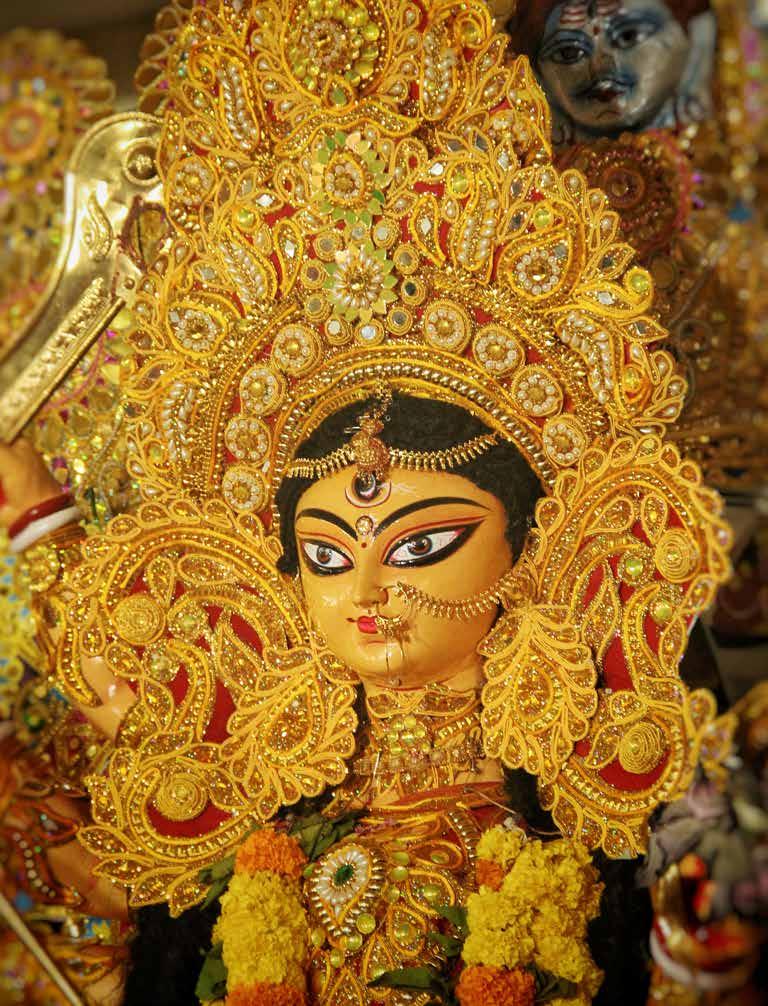

According to Hinduism, the goddess of justice is Shakti, who is depicted as a lion-seated deity with ten arms. Bengalis believe that each of the ten weapons held by Shakti in her ten hands has its own unique significance. There is a belief that these weapons are symbolic of the celestial qualities that other gods have bestowed upon Shakti to combat evil. In the eyes of Bengalis, the entry of Durga is not merely a mythological tale; rather, it is also a sentimental return to their homeland. Shakti is revered as the daughter who bestows joy and prosperity upon her devotees. She is also accompanied by her offspring Lakshmi, Saraswati, Karthikeyan, and Vinayaka when she goes back to her father's house.
At the beginning of the Durga festival is the Mahalaya, which is a prayer offered to the goddess Durga during the Navratri celebrations. At the festival, each day is given a unique name that is associated with it. It is on the day of Shashti that the goddess finds her way back to her earthly dwelling. The people eagerly await the unveiling of the goddess's idols in the pavilions.
On the day of Saptami, a ritual involves binding together nine different kinds of plants. This particular belief in the presence of the goddess in the natural world is a special one. However, Ashtami is regarded as the most fortunate day of the year. Kumari Puja and Shanti Puja are two sacred rituals that are performed in the pavilions on this day by Bengalis who are clothed in their traditional garb. Throughout the night on the day of Navami, there are festivities with family members, as well as dancing and cultural performances that involve the use of incense sticks.
The idol of Durga is worshipped on the final day of Dashami, also known as Vijayadashami, and then it is carried in a procession before being submerged in the surrounding water. This event signifies the goddess' return to her heavenly abode. At that time, women administer saffron to each other and exchange greetings.
All over the world, Bengali Durga Puja ceremonies serve to unite the diaspora with their cultural origins. By doing this, Bengalis were able to spread the foundations of their culture and customs to many parts of the world. The Kolkata Durga Puja was included on the Representative List of the Intangible Cultural Heritage of Humanity by the United Nations Educational, Scientific, and Cultural Organisation (UNESCO) in the year 2021. When viewed through the perspectives of its many different ethnic groups, India is a magnificent country.
With a zeal for culinary experiences transcending the ordinary, the art of food presentation never ceases to surprise. From the intricacies of using multi-sensory to unconventional dining experiences, culinary presentations have evolved significantly over centuries. It brings about deep insights into cultural shifts with progressive changes seen in culinary art in fine dining.
Sahana Subramanya
Evolution of Culinary Experience
The conventional fine dining experience has blossomed from a mere plating of delicacies with the emphasis being more on flavours and taste. Now, it is about the meticulous creations of the chefs, presenting their specialities most uniquely.
Looking at the times of the Roman period, the pompous feasts hosted by the higher class of society, made it a grand affair. The feast lasted for hours, with a blanket of food on their table, making it a lavish affair. With a variety of delightful dishes, it was evident the feast was held to accentuate the wealth and status of the elite in the society.
A contrast was seen in French cuisine which resonates with sophisticated and elegant culinary experiences, with pre-set standards. These standards were more evident during the reign of Louis the 14th from the 18th century, with prominence given to the ‘Haute cuisine’ meaning high cuisine. The characters included fine yet intricate cooking abilities with detailed presentation techniques, showcasing the skills of chefs.
Then came the Nouvelle cuisine during the 1970s, which revolutionised French fine dining, highlighting lighter meals yet flavourful dishes using fresh ingredients and whole foods. During the late 20th and early 21st century, a unique blend of dishes from different regions making their way into French cuisine, became a popular trend in those times.
Significance of Fine Dining
The revelation of culinary experience commenced while fine dining gained importance in society, as it is a pivotal part of creating an experience worth reminiscing. Here, the visual aesthetics are given importance to, directing the spotlight on the overall perception of the dishes chosen for an evening dinner or a social gathering. The mantra was to ensure the diners enjoyed their meal to the fullest, taking their culinary expectations to new heights. The game of taste buds was on, adding a benchmark for impressing sensory delight and playing with their emotions that brought a level of satisfaction, filled with surprise.
A Guide to a Few Dining Etiquettes:
In a social gathering or a restaurant, dining etiquettes are followed to rise to the occasion and spice up the experience with a dash of table manners. This helps in blending perfectly with the crowd and ensuring to avoid the awkwardness amongst the gathering. Lets see more on this:
• Be mindful that a fork is not to shovel a mouthful of food into your mouth, but an instrument to lead the food seamlessly through your taste buds.
• When offered a dish from a neighbour, be polite to take only a tiny portion of it.
• Strictly no phones allowed during meals, especially when you have companions. This shows respect and indicates you value their time with you, more than anything.
• A loud mouth around, while talking, or chewing or doing both is a total put-off to people around you. Ensure you avoid this situation as silence is the best way to fit into the crowd of companions, for a special meal with you.
• Thank the host genuinely for having invited you for the meal, and if it is in a house, then graciously offer to clean up after.
• Always be polite to the person serving your table and helping you with food, as it is because of them that you are having a fine experience.
How Culinary Presentation Made its Way for the Rise of Exploring Food
First Impressions:
A first look at a diner’s dish is enough to create a whole new perspective on that dish, even before putting it into the mouth. We usually consider a visually appealing dish with adornments with just one glance, though the dish may fail to satisfy the taste buds. The visual cues are coaxed while presenting. For instance, a Penne Arrabiata is perceived to be spicy with its bright red sauce, while a bechamel sauce gives cues of a cheesy creamy pasta even before digging in.
A Chef’s Glory Through Innovations:
A chef is a culinary artist, looking for chances to feed nothing but the best in fine dining. He never fails to seize an opportunity to impress you with his culinary prowess, to convert conventional food into a piece of art. When I say food, usually the importance here is given to the taste that has remained the same throughout the years; however, the visual appeal is somewhere lost. That is where the skills of the chef come into the picture, to uplift the dish visually, bringing it closer to the feelings of what the taste brings to a diner.
Cultural Aspects Connecting World Cuisine:
A variety of cuisines with unique presentation techniques are reflections of cultural values. A simple yet effective means of connecting people to different backgrounds fostering a sense of appreciation for cultures. For instance, while Colonialism gained prominence, numerous colonised regions were introduced to European cuisine. An interesting aspect of how culture seems very significant is that a dish in one region undergoes variation with minor additions in another. For instance, the fish fry masala in Kerala is comparatively different from that in Kolkata. However, it is unique to the region with bursting flavours to savour.
A Harmonious Blend in Aesthetics of Fine Dining:
While culinary presentation highlights appealing visual representation of dishes, there is more to it than meets the eye. It becomes an intricate artwork of the chef, where he balances different aspects that seem pleasant to the palate involving texture, colour, taste and proportion. By combining these aspects seamlessly, the chef is bound to create an enchanted experience for the diners. Let’s take the famous seared scallops of a dish. A dish of small quantity, the scallops are placed inside the shells, and drizzled with a creamy, buttery sauce. This by itself would not seem to fill in a diner’s delight, but when accompanied by a cheesy polenta and tray of olive-drizzled fresh and crispy kale chips, you call that an experience!
Uplifting the Aesthetics with Garnish
Enhancing flavours:
Throughout the world, many cultures give importance to the final touch with garnish. They are more than just decorative elements, they are what give a soul to the dish. A simple addition of lemon zest for seafood, brings a burst of acid freshness, or fresh herbs like basil to a tomato sauce, enhances the pasta or the Indian elements of a Tadka including mustard seeds, cumin seeds, urad dal, curry leaves and a pinch of asafoetida enhances a simple dal to be a comfort meal to many. Simply put, garnish is what it does to a dish, that icing does to cake!
Going Beyond Plating:
While the plating and presentation concentrate on tickling your taste buds and playing with your emotions, larger details like table setting, lighting and food photography add to the fervour of enjoying the dishes.
The elegance of plain linen tablecloth, with glass and tableware, provides a pleasant ambience. Complimenting this setting, are the lights that uplift the beauty of a dish, with better lighting for a perfect shot for food photographers, who show their mastery in capturing the freshness of the food. This is a common practice when it comes to food bloggers and travellers who want to showcase a dish on social media.
Conclusion
Over the years, the culinary presentation has bloomed with a blend of influences from the global trade, cultural and religious aspects, to the aesthetics of fine dining.
It goes beyond just satiating your hunger, as all the above aspects are put together in a beautiful symphony of colour, taste, visual treat, and the aroma of your favourite dish lingering through the perfect ambience of a fine dining restaurant to become an eventful experience worth remembering, adding a treat to your senses.
A FUN DIVE INTO THE WORLD’S BIGGEST BEER BASH
What if you saw tens of thousands of people gathered in sprawling beer tents, clinking massive steins filled to the brim with frothy beer, all while a brass band belts out festive tunes in the background. Outside, crowds are munching on oversized pretzels, sausages, and roast chicken, while carnival rides whirl in the distance. Welcome to Oktoberfest, the world’s largest and most legendary beer festival!
Aishwarya Abhishek Singh
What Is Oktoberfest?
Oktoberfest isn’t just a beer festival; it’s a full-blown cultural event that celebrates all things Bavarian - beer, food, music, and tradition. Held annually in Munich, Germany, this festival starts in midSeptember and runs through the first weekend of October.
Each year, over 6 million visitors from all corners of the globe flock to this Bavarian mecca to experience a party like no other. At the heart of the celebration are the enormous beer tents, set up on a sprawling 100-acre area known as the Theresienwiese, affectionately called the “Wiesn.” Inside these tents, visitors toast with steins of
Munich’s finest brews, dance on benches to the beats of traditional Oompah bands, and sing their hearts out to songs they might not even understand (but who cares when you’re having fun?). The festival isn’t just for beer lovers either - there’s something for everyone. Carnival rides, parades, and tons of traditional Bavarian dishes make it a family-friendly event with plenty to do.
How Oktoberfest Came to Be: A Royal Wedding Gone Wild
Let’s rewind to 1810, when a royal wedding set the stage for what would become this global phenomenon. Crown Prince Ludwig (who later became King Ludwig I
of Bavaria) was marrying Princess Therese of Saxe-Hildburghausen, and the couple wanted their nuptials to be a celebration for the people. On October 12, 1810, they invited the citizens of Munich to join in the festivities, which featured a public horse race held just outside the city gates.
The event was such a hit that the people decided to do it all over again the following year—and the year after that. By 1818, the focus began to shift away from horse races to include booths selling beer and food. Fast forward to the late 19th century, and Oktoberfest had evolved into a massive beer festival that continues to thrive more than 200 years later.
Why Is It Celebrated?
Originally, Oktoberfest was all about celebrating Bavarian culture and royal marriages, but today, it’s all about beer, fun, and bringing people together. Bavarians are incredibly proud of their brewing heritage, and Oktoberfest is the perfect platform to showcase the quality and tradition of Munich’s beer.
The beer served at the festival is brewed according to strict purity laws, known as the Reinheitsgebot, which dates back to 1516. According to these regulations, beer can only be made using water, barley, hops, and yeast—no funny business allowed! Even today, only six Munich breweries— Augustiner, Paulaner, Hofbräu, Hacker-Pschorr, Löwenbräu, and Spaten—are allowed to supply beer to the festival, making it an exclusive showcase of Munich’s finest.
The Big Bash: Beer, Food, and Fun
Let’s talk beer. At Oktoberfest, beer is not served in regular pint glasses, but in giant Maßkrüge—those iconic one-litre mugs that are practically a workout to lift! In total, over 7 million litres of beer is consumed at Oktoberfest each year.
To kick off the festivities, the mayor of Munich performs the traditional O’zapft! (It’s tapped!) by ceremoniously tapping the first keg, signalling the official start of the beer festival.
But it’s not just about drinking. The food is a major highlight too. Traditional Bavarian fare includes giant pretzels (bigger than your head!), Bratwurst, Weißwurst (white sausages), Hendl (roast chicken), and Schweinshaxe (pork knuckles). It’s hearty, delicious, and perfectly paired with a cold beer. For those with a sweet tooth, there are Lebkuchenherzendecorative gingerbread hearts - often given as gifts.
Beyond beer and food, Oktoberfest offers a variety of activities. There’s a lively carnival with amusement rides, games, and attractions for both kids and adults. There are also cultural events, including the Costume and Riflemen’s Parade, which showcases traditional Bavarian outfits and marks the rich history of the region.
A Global Phenomenon
Although Oktoberfest originated in Munich, its popularity has spread across the globe. Today, you can find “ Mini-Oktoberfests” in cities from New York to Sydney, and even in Tokyo and São Paulo. However, none can quite match the scale and authenticity of the original event in Munich. Still, these international versions bring a slice
of Bavarian life to millions of people who may not have the chance to travel to Germany. Whether it’s German beer, food, or music, Oktoberfest has become a global ambassador of Bavarian culture.
Fun Facts About Oktoberfest
16 to 18 Days of Fun: While it’s called Oktoberfest, most of the event actually takes place in September to take advantage of the warmer weather.
6 Million Visitors: Every year, over 6 million people descend upon Munich, including tourists from the U.S., Australia, Japan, and all over Europe.
Traditional Dress: Many attendees wear traditional lederhosen (for men)
and dirndls (for women), adding to the festival’s authentic feel.
7 Million Litres of Beer: That’s how much beer is consumed during Oktoberfest. If that sounds like a lot, consider that the beer is stronger than typical varieties, with an alcohol content of about 6-7%.
At its core, Oktoberfest is a celebration of Bavarian culture, history, and community. It’s a time for people to come together, make memories, and share in the joy of good beer, food, and festive traditions. Whether you’re there for the beer, the food, or the fun atmosphere, Oktoberfest promises an unforgettable experience filled with cheer and camaraderie. Prost!
Craving a comforting escape beyond the old pasta and lasagna? Cannelloni offers a flavorful journey with rich flavors and storied history, from its ancient Roman beginnings as ‘lagani’ to today’s tubular delights.
Cannelloni is more than just a meal; it’s a tradition, a celebration shared between loved ones, serving as a witness to Italian traditions. Cannelloni
are characterized by their tubular shape and are typically filled with spinach and ricotta cheese. However, its versatility allows for endless variations, from savory beef and cheese fillings to creative combinations tailored to individual tastes. This adaptability has contributed to cannelloni’s popularity worldwide, with each culture adding its own unique twist to the classic recipe. Cannelloni is often served as a
main course, together with a salad or garlic bread. But hold on to your forks, because cannelloni isn’t limited by borders—it’s enjoyed around the world with its own unique twists. In America, it’s called manicotti—a slightly larger, thicker version with ridges.
Before we get into the kitchen, let’s gather our ingredients - the essential tools for crafting this flavorful dish.
Ingredients for sauce
• 2 tablespoons of olive oil
• 1 finely chopped onion
• 4 minced garlic cloves
• 1 fresh bay leaf
• 1/2 teaspoon each of dried thyme and oregano
• 1/3 cup of tomato paste
• 800 grams (28 oz) of canned crushed tomatoes
• 4 cups of vegetable broth
• 1/3 cup of Chardonnay or dry white wine
• 3/4 teaspoon of salt
• 1 1/2 teaspoons of sugar
• 1/3 teaspoon of black pepper
• 2/3 cup of roughly torn basil leaves
Ingredients for the Filling
• 250 grams (8 oz) of thawed frozen chopped spinach
• 500 grams (1 lb) of full-fat ricotta cheese
• 1/3 cup of finely shredded Parmesan cheese
• 1 cup of shredded cheese (Mozzarella, Cheddar, etc.)
• 1 egg
• 1 minced large garlic clove
• A sprinkle of grated fresh nutmeg or nutmeg powder
• 3/4 teaspoon of kosher salt
• 1/2 teaspoon of black pepper
Ingredients for the Cannelloni
• 18–22 dried cannelloni tubes
• 1/3 cup of shredded Parmesan cheese
• 1 1/4 cups of shredded Mozzarella cheese
• Additional basil and Parmesan for garnish (optional)
Now that we are ready with our ingredients, it’s time to get into the kitchen.
Let’s begin the show with the filling:
For the ricotta and spinach filling, begin by wilting the spinach gently. Combine it with creamy ricotta, Parmesan cheese, a beaten egg, and your preferred seasonings. Consider this mixture as your blank slate; add a bit of nutmeg for warmth and some herbs for freshness to suit your taste.
Now, the moment of truth—assembling the cannelloni: Using a piping bag or a spoon, gently fill each tube with your chosen filling. Don’t overstuff. Alternatively, if you’re feeling patient, you can spoon the filling into the tubes with a knife – although it may take a bit longer!
Next, the sauce simmers:
1. Sauté Aromatics: Put pot over medium-high heat, add oil. Toss in the garlic, onion, bay leaf, thyme, and oregano, and cook until the onion is perfectly translucent, which usually takes 3-4 minutes. Then, add some tomato paste and let it cook for another minute, when it releases a tempting aroma.
2. Wine Infusion: Time to add a touch of sophistication! Pour in the wine and crank up the heat. Let it bubble away vigorously until it evaporates, infusing the sauce with layers of delightful flavor. This step is where the magic truly begins.
3. Simmer Magic: Now, it’s all about building those robust flavors. Add tomatoes, a hint of sugar, salt, and pepper. Stir gently, then reduce the heat to a simmer and let it cook for 20 minutes, allowing its depth and richness to develop.
4. Blitz to Smoothness: Once the sauce has reached to desired consistency, remove the bay leaf and grab your trusty stick blender. Give it a
whirl until it transforms into a velvety-smooth sauce. Let it simmer for an extra minute, further enhancing its luxurious texture.
5. Basil Finale: Ah, the crowning touch! Stir in fresh basil leaves, adding a burst of herbaceous freshness. Cover the sauce to keep it warm.
Finally, the grand finale—baking and serving:
1. Preheat the oven to 180°C/350°F.
2. Pan: Select a baking pan that comfortably accommodates around 20 cannelloni.
3. Smear: Begin by spreading a generous cup of sauce evenly across the base of your chosen pan. This simple step prevents the cannelloni from slipping and sliding during baking.
4. Assemble: Carefully arrange your filled cannelloni in the prepared baking dish, ensuring they snugly fit. Pour the remaining sauce generously over the top, making sure every tube gets a loving coating.
5. Bake it: Cover the dish with foil and bake for 30 minutes.
6. Cheese it!: Take out the pan, remove the foil, sprinkle generous amounts of parmesan and mozzarella on top, and bake for an additional 15 minutes until the cheese is golden and melted.
7. Serve and enjoy: Once out of the oven, garnish with additional parmesan and basil, if desired. Gather your loved ones, appreciate the effort you put into cooking, and enjoy the delicious, melting flavors of your homemade cannelloni.
Accompaniments: Have your yummazing meal with a refreshing green salad, crusty bread, or roasted veggies. These additives improve the overall dining experience by adding depth and flavor to your dish. Remember, it’s cannelloni. Enjoy every bite!






